Sea Clarity, day 1: Call
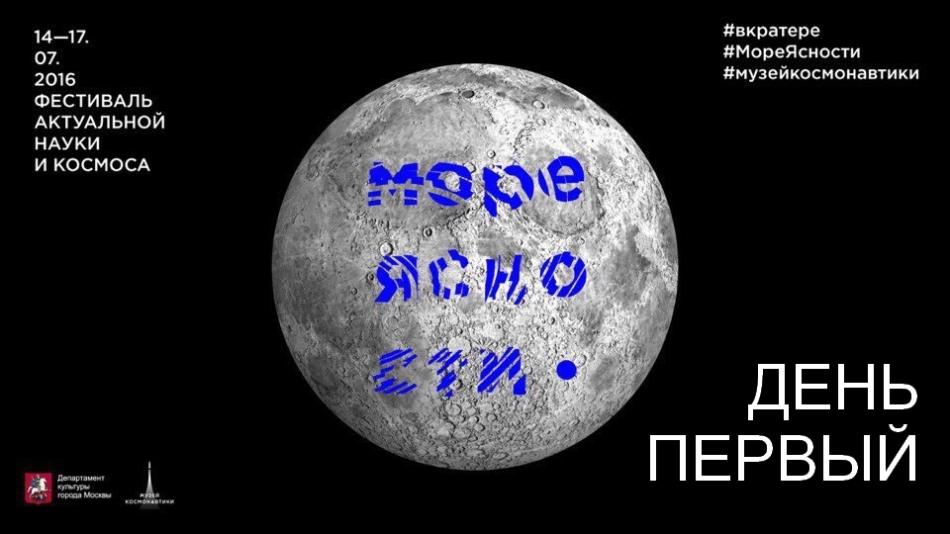
Four days, three lectures, seven museums, fifty-six kilometers traveled (and two corns), 3477 photographs, one forty-minute program and a couple of interviews - these are the results of my trip to the “Sea of Clarity” festival held on July 14-17 by the Moscow Museum cosmonautics. I bring to your attention the report of this trip.
First day program:
- Flight
- VDNH and the exhibition "Space: the birth of a new era"
- First Day of the Sea of Clarity
The flight to Moscow is not related to astronautics, just beautiful photos, so under the spoiler
Random luck - window seat and a warm atmospheric front made it possible to take some beautiful photos. In the area of Ufa, cloudiness did not exceed one point, but a couple of clouds caught right on the take-off trajectory.

')
The most beautiful views open from a height of about 200-2000 m.
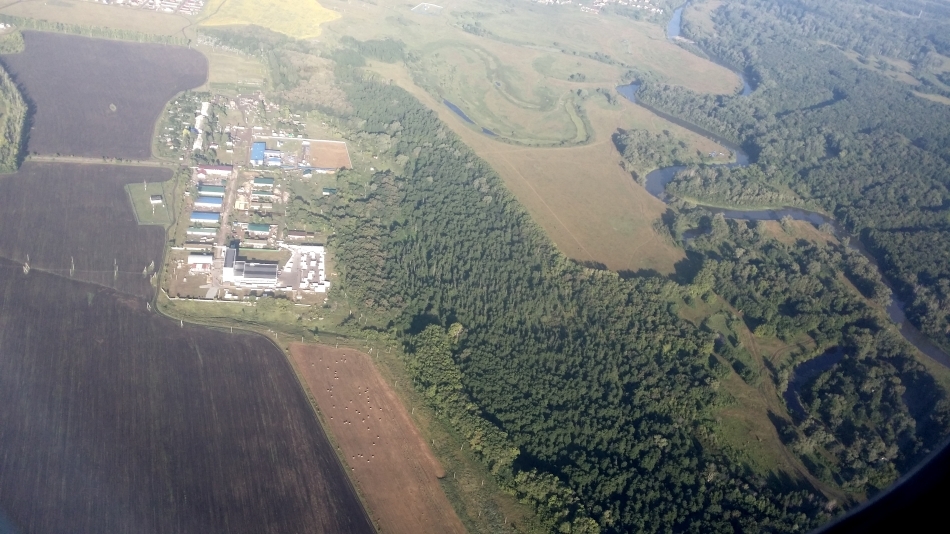
Another pleasant coincidence, the Kandra paradrom sails below, one of the best places for delta and paragliding in Bashkortostan.

The road to Moscow passes to meet the warm atmospheric front, so the clouds begin at high altitude and then descend below.




And this picture is associated with the "Smoky Sea" by the Strugatskys. Nothing can be done, you have to dive there.

Flight
Random luck - window seat and a warm atmospheric front made it possible to take some beautiful photos. In the area of Ufa, cloudiness did not exceed one point, but a couple of clouds caught right on the take-off trajectory.

')
The most beautiful views open from a height of about 200-2000 m.

Another pleasant coincidence, the Kandra paradrom sails below, one of the best places for delta and paragliding in Bashkortostan.

The road to Moscow passes to meet the warm atmospheric front, so the clouds begin at high altitude and then descend below.




And this picture is associated with the "Smoky Sea" by the Strugatskys. Nothing can be done, you have to dive there.

VDNH and the exhibition "Space: the birth of a new era"
For some reason I decided that the exhibition was in the pavilion "Cosmos" and went to him. Near the pavilion there is a rocket "Vostok". A hole from above is necessary for the rescue system to work - in the event of a launch vehicle accident on the Vostok ship, the hatch should have been fired off, and the astronaut should be ejected. On the Soyuz rockets, the rescue system works differently , and there the fairing is solid.

Notice how far the rocket is below the installer. This was done deliberately so that the lower, widest part of the rocket hid in the launch structure to protect against the wind. When the R-7 was designed, they initially even wanted to build a wall around the start, but, fortunately, they came up with a much more beautiful solution.

Now there are no exhibitions in the pavilion "Cosmos", you can see desolation in the door slot.

And the exhibition "Cosmos: the birth of a new era" is in pavilion number 1, it is "Central"
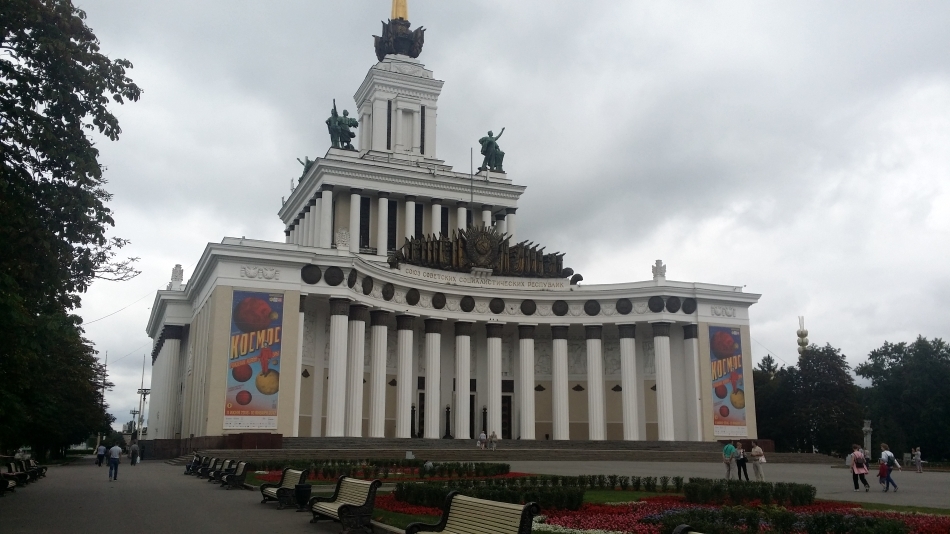
The exhibition "Cosmos: the birth of a new era"
Admission : 250 p.
Photographing : Free.
Overall rating : Go necessarily.
The exhibits are placed approximately in chronological order, so we begin with the fantasies and dreams of the early 20th century. For example, the cabin of the transport of the future, as seen in the 20s.
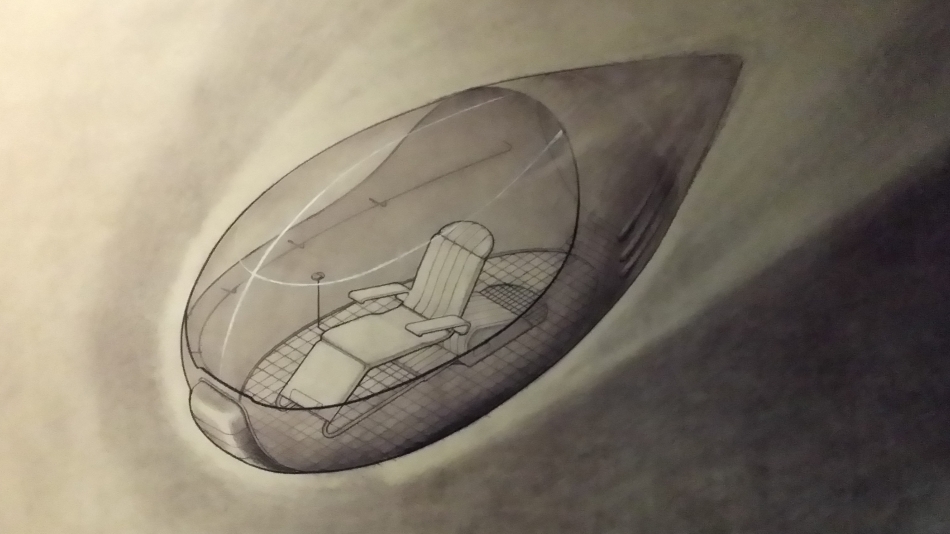
Reflections Tsiolkovsky about how people will live in weightlessness. Items in the baskets (come true, but Tsiolkovsky did not know about stickies), food in the baskets, water in a rotating container (did not come true, we cope, and so), wings for flying around the station (while there is little space, it did not come true).

"Tying around a rocket" is so cute. Immediately the problem of a broken cable was managed to catch someone, and someone died. Individual engines that were in reality did not occur to Tsiolkovsky.
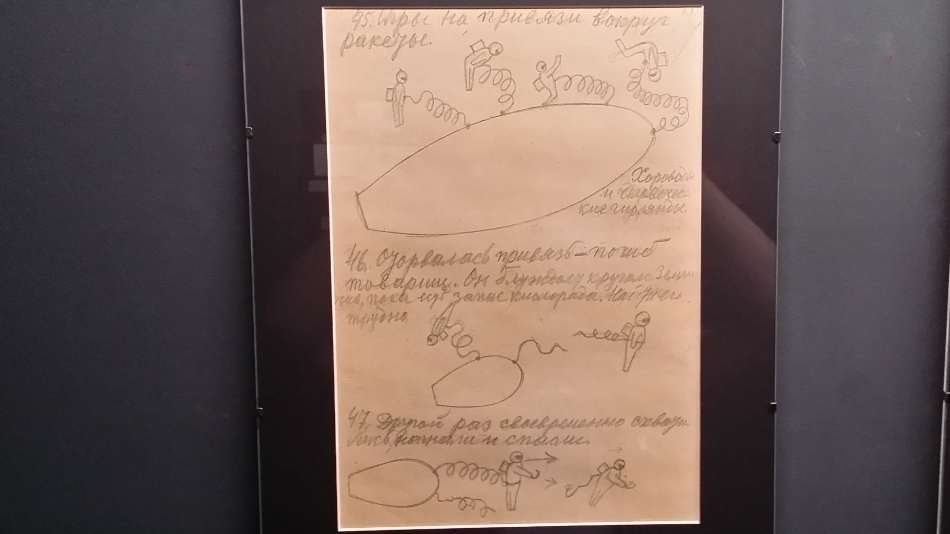
If we are talking about Tsiolkovsky, the most obvious artifact is the auditory tube. Konstantin Eduardovich, due to illness in childhood, had hearing problems and was forced to use a special auditory tube.

Historical fact - Korolev was repressed and at least twice survived miraculously. Therefore, the exhibition has his camp mug, the only thing he brought from Kolyma. On the right is the Queen's glove, which he wore in 1946 in Kapustin Yar, creating the first Soviet ballistic missiles.

And this stand is dedicated to the sculptor Anatoly Grigoriev, who was fond of cosmism, and in 1948 he was arrested in the case of the “Soviet Theosophical Society”.
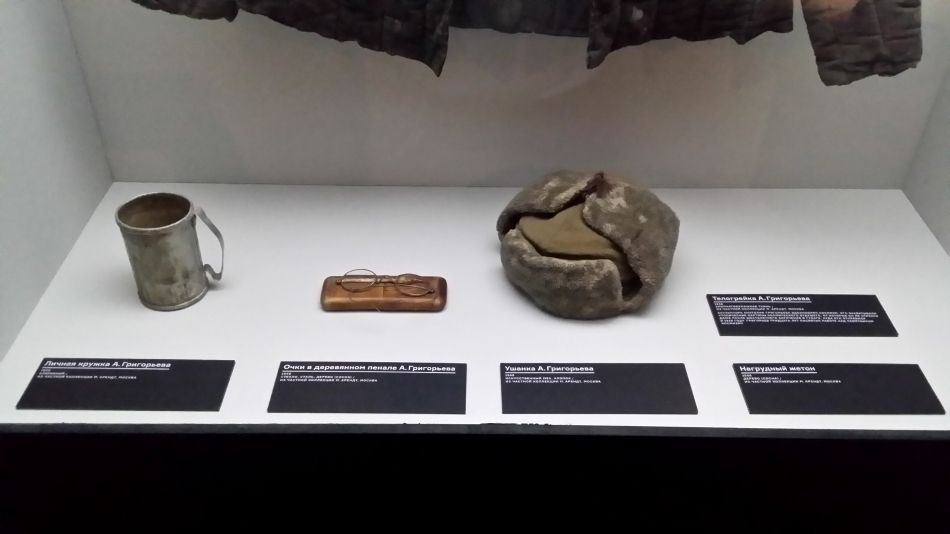
Model of a spacecraft designed by Tsiolkovsky. In this project, there was a brilliant guess; oxygen and hydrogen, the most efficient of the available, were offered as fuel for the ship.

Historical document - Resolution of the USSR Council of Ministers on the establishment of the Committee on Rocket Technology:
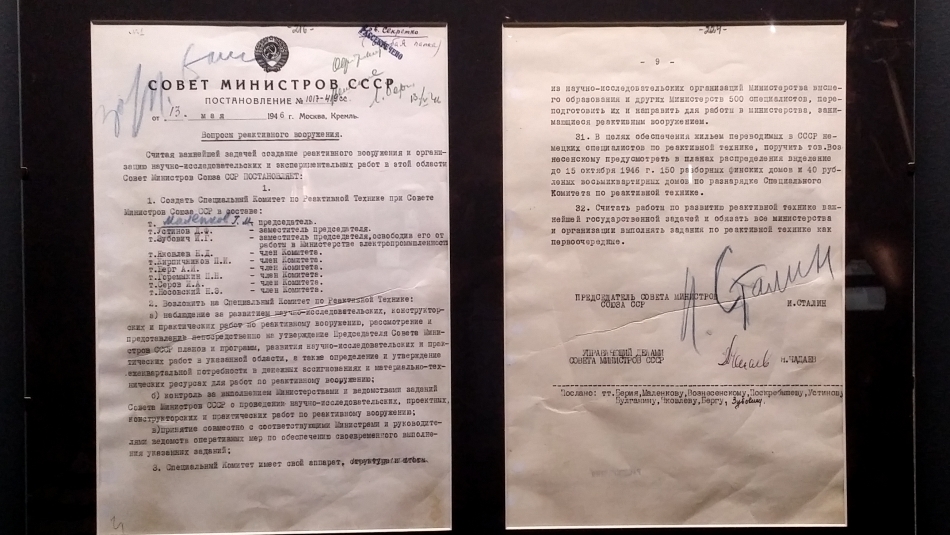
A pair of curious exhibits. A letter of a 42-year-old collective farmer who wants to fly into space.

A bottle of champagne, which stands on the stand with photos of SP The Queen has the following story (as presented by B. E. Chertok):
Humanity admired us and all Soviet people were proud, not knowing our names. But we did not grumble about it. “Our feat,” the JV said, “is appreciated not only by humanity, but also by a rich French winemaker. He announced that he would give a thousand bottles of champagne to those who show the opposite side of the moon. He was sure that we would fail, and he was not afraid of risk. But after losing, he kept his word. True, there was a hitch. The winemaker appealed to our embassy in Paris with a request to inform whose address to send champagne to. The embassy was confused and requested the Foreign Ministry. After multi-tiered approvals, the Foreign Ministry gave instructions to send bottles to the Presidium of the Academy of Sciences. Now we are honored to receive several dozen bottles of champagne from the warehouse of the Academy of Sciences. You will get a couple of bottles, the rest will disperse among the apparatus and other uncomplicated. ” We have slandered a lot about this. But still bring home French champagne in the evening to the family meeting of the New Year, received as a gift for the Moon - agree that this is not given to everyone.
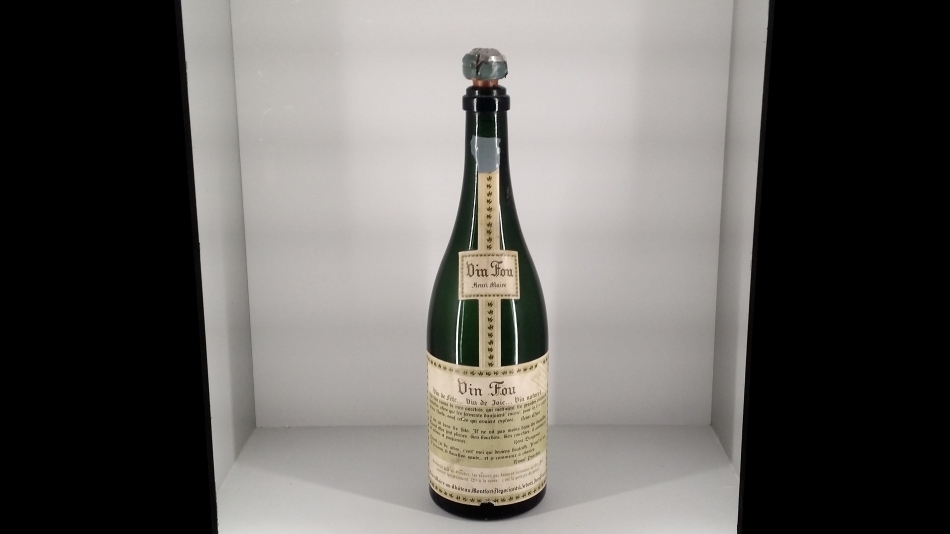
On the wall with posters there are a couple more rare
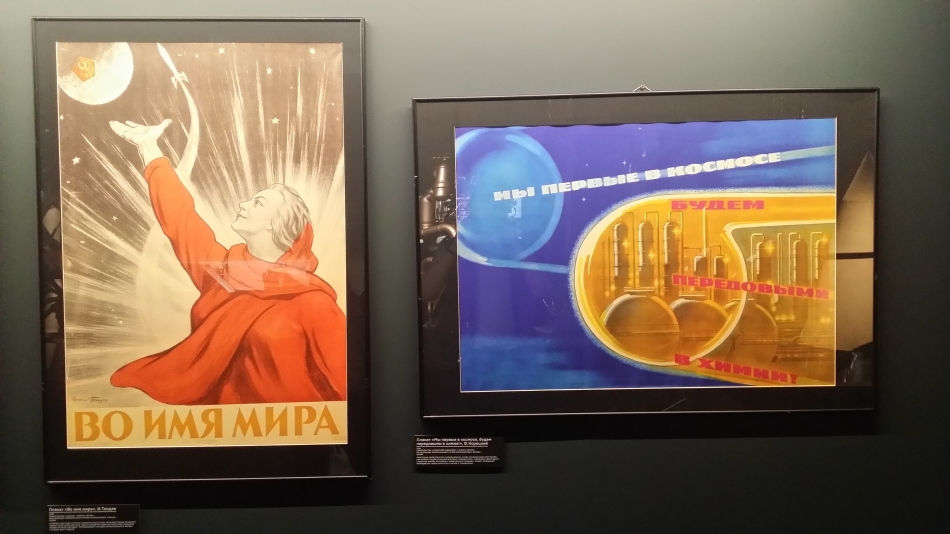
Then begin the exhibits associated with the first flights into space. Titov's movie camera (he was the first to film from orbit).

Costume Tereshkova.
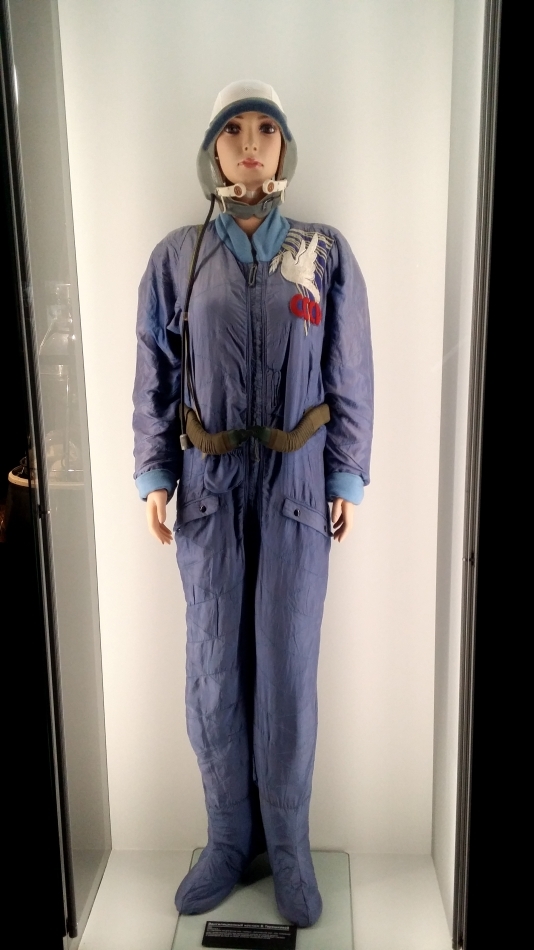
Drawing Leonov, made in orbit.
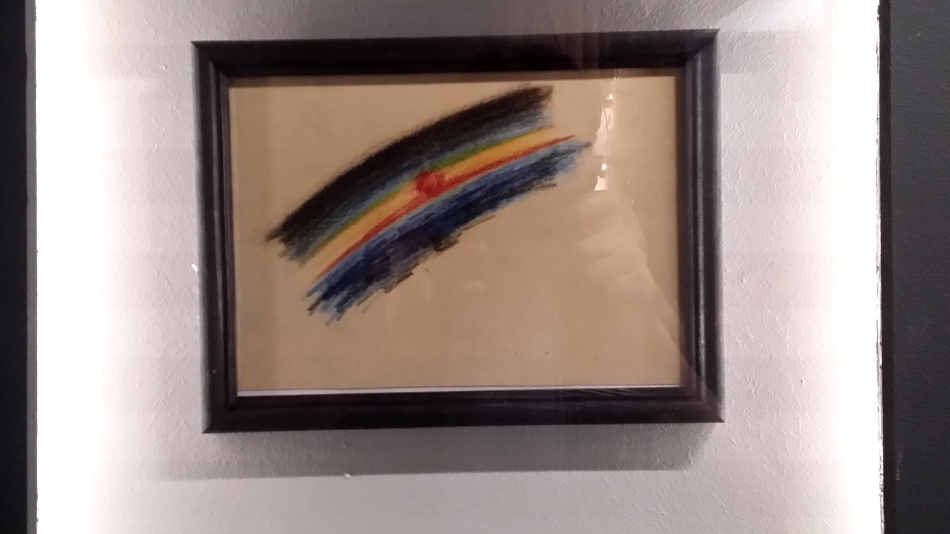
Two things struck me in technical exhibits. First, the cabin "Voskhod-1". Yes, I knew with my mind that in the "ball" of the "East" for one person they managed to stuff three. But when you see this cockpit with your own eyes, there is a feeling that even Tirion Lannister with Miles Vorkosigan would be cramped there, not to mention the three Soviet cosmonauts "no more than 170 cm tall."

Pay attention to the farthest cradle - legs will rest against the dashboard.

The second surprising thing is the Tereshkova descent vehicle (Vostok-6). It is known that Gagarin was blocked in flight, in case he suddenly went insane. After his flight, it became clear that this protection measure is excessive. But all subsequent astronauts flew with the code lock turned off - if the project is approved, they will no longer change it, even if this combination lock is not needed. Here it is, on the top of the left dashboard, six buttons.
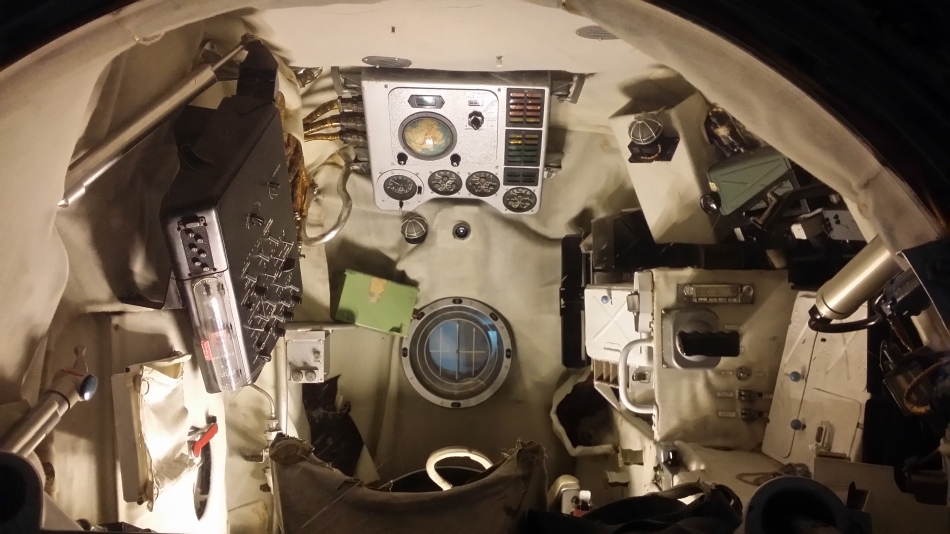
Not a very common angle - the cosmic thermal protection of the Vostok was in the form of hexagons.

It also seems that Raikin said: “a person strives to inhale pure oxygen, and to exhale all kinds of muck”. Astronauts are no exception. And in the closed volume of the cabin with this filth, something must be done. And besides the obvious carbonic acid, a person still exhales water vapor. If it is not removed from the atmosphere of the ship, then soon all surfaces will be covered with dew. And this is not only unpleasant, but also can be deadly because of the risk of a short circuit. Therefore, on all manned ships, the atmosphere is also dried. Here is the drying unit of the Voskhod ship.
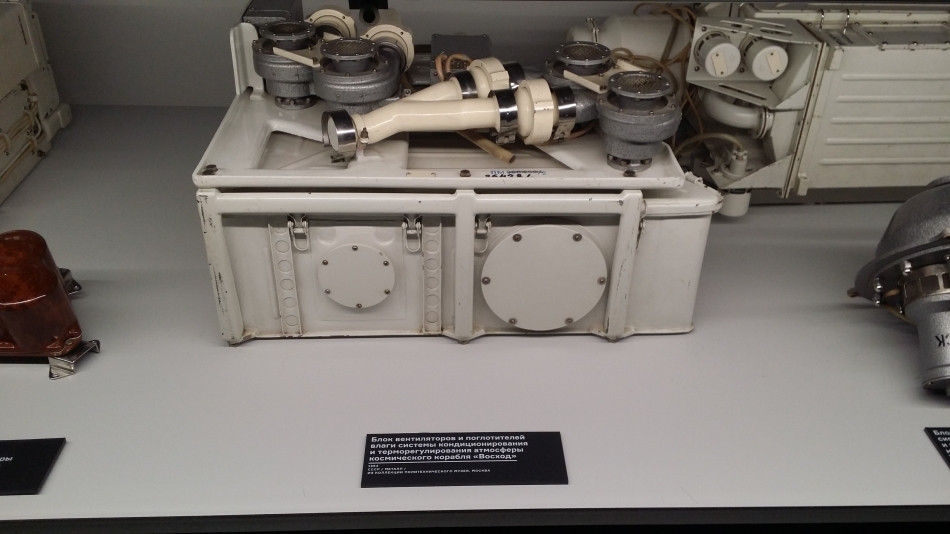
At the exhibition there are several more seemingly unremarkable boxes, without which the flight is impossible. Here is an installation that absorbs carbon dioxide.

Boris Volynov's loading suit, obviously, from Soyuz-21. From these experiments, the Penguin loading suit, which is used now on the ISS, has grown

Installation for moving and maneuvering astronaut 21KS. American MMU flights are widely known, but the USSR had a similar program, according to which in 1990 they even performed two tests in space.
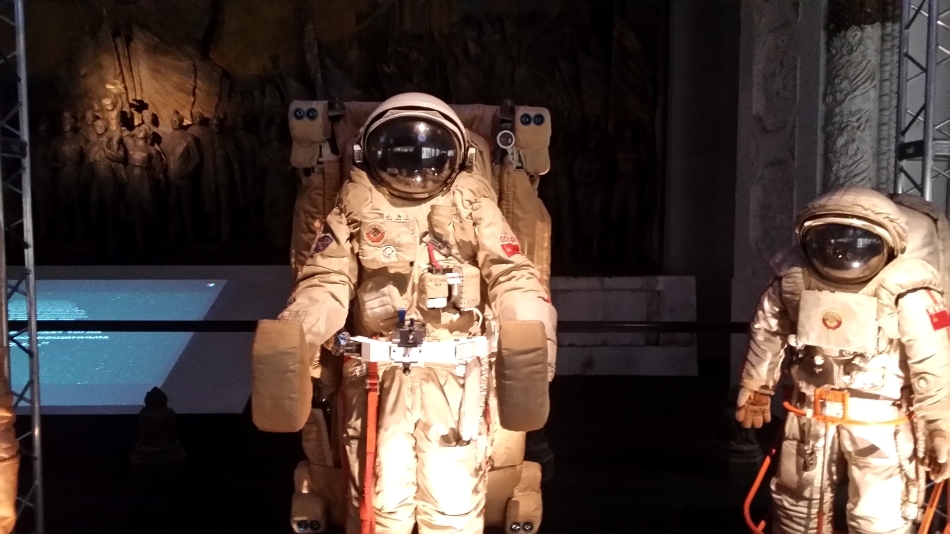
Space suit of the Mars-500 isolation experiment.

The whole wall is dedicated to Galina Balashova, our space designer ( film about her ).
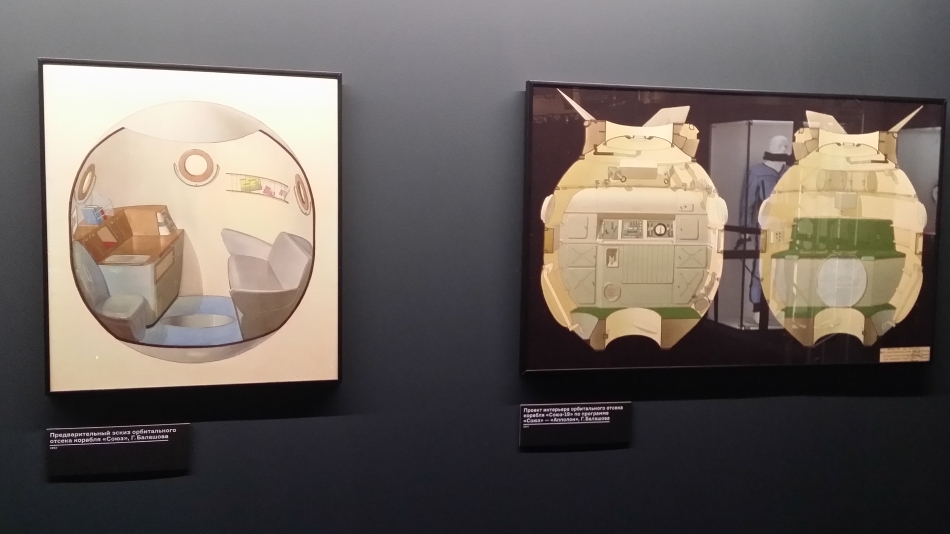
Phantom dummy to study the effects of cosmic radiation on humans. The official name is “FM-2”, but, probably, it would be more correct to call it “Hello, Yura!”

The "Union" has a periscope for docking - "Vizir special astronaut." The periscope is reset before entering the dense layers of the atmosphere, but part of it remains on the descent vehicle. It is interesting to see how it looks from the outside.

Dashboard "Soyuz-T" ( modifications "Unions" here )

Pressure chamber. Space technology helps people.

"Lunokhod"
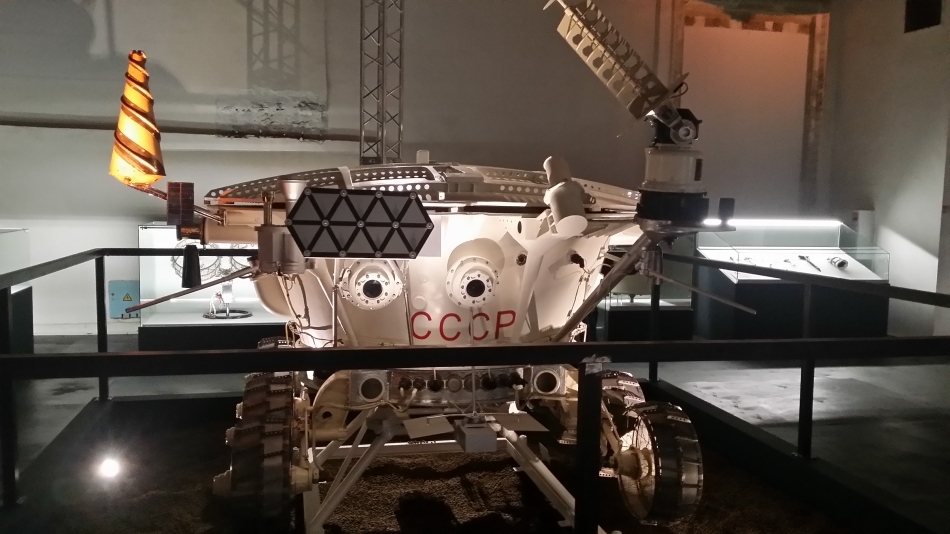
The descent vehicle "Venus-7". This station managed to make a soft landing in the hellish conditions of pressure of one hundred atmospheres and temperatures of 500 ° C. For example, the parachute had to be made of glass nitron. Nitron (an acrylic version) in the process of landing burned out, and the device went down on glass filaments. Glass was used in the descent vehicle - fiberglass, glass wool.

Finally, the last room. There is only one exhibit in it - the LK-3 lunar landing module. Because of the limitations on the payload of the H-1 lunar rocket in the apparatus, they made many compromises. The crew of LK-3 was supposed to be only one person, so we see only one porthole.
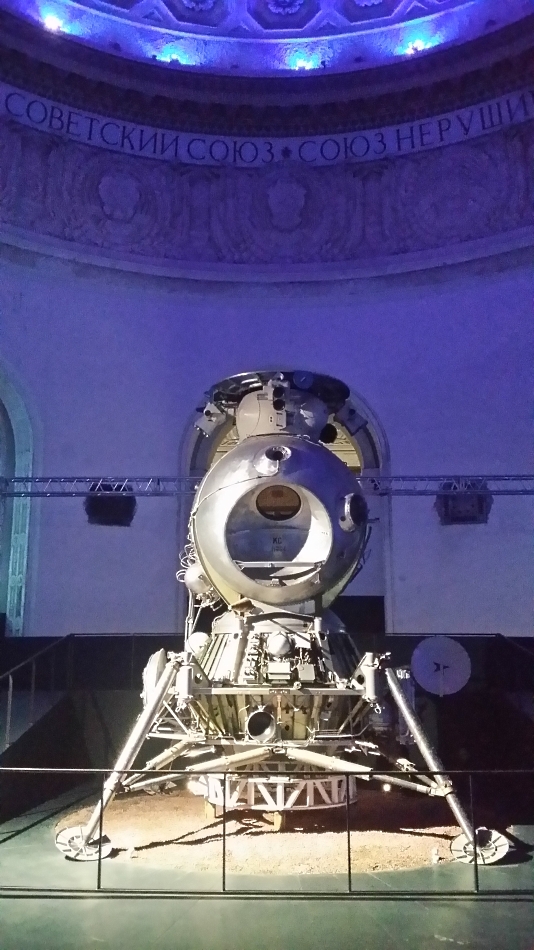
The docking unit was without an internal manhole - in order to return to the ship flying to Earth, the astronaut would have to climb into it through open space.

At the same time, some solutions seem redundant. For example, there are visible special engines, which were supposed to press the ship to the surface in case of landing on a slope.
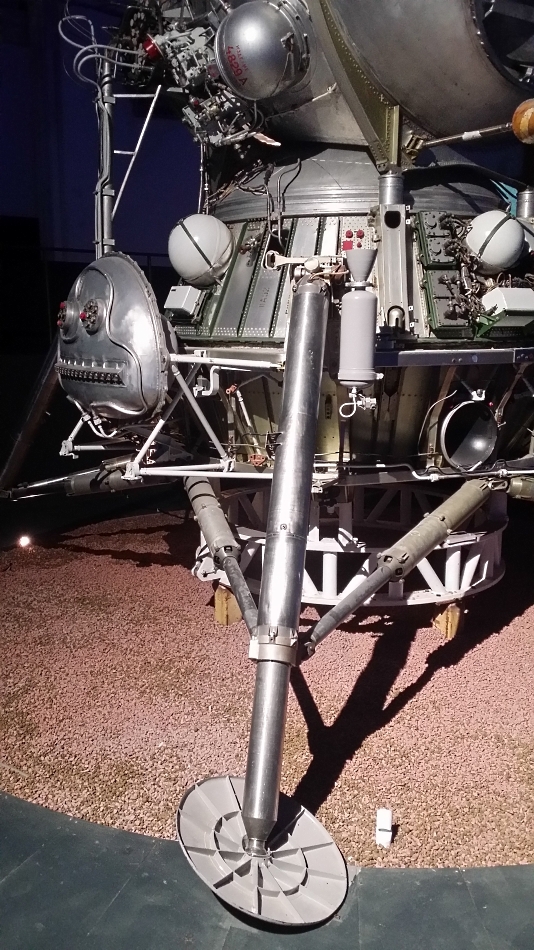
The sealed unit of the instrument cluster is not very happy to us ...
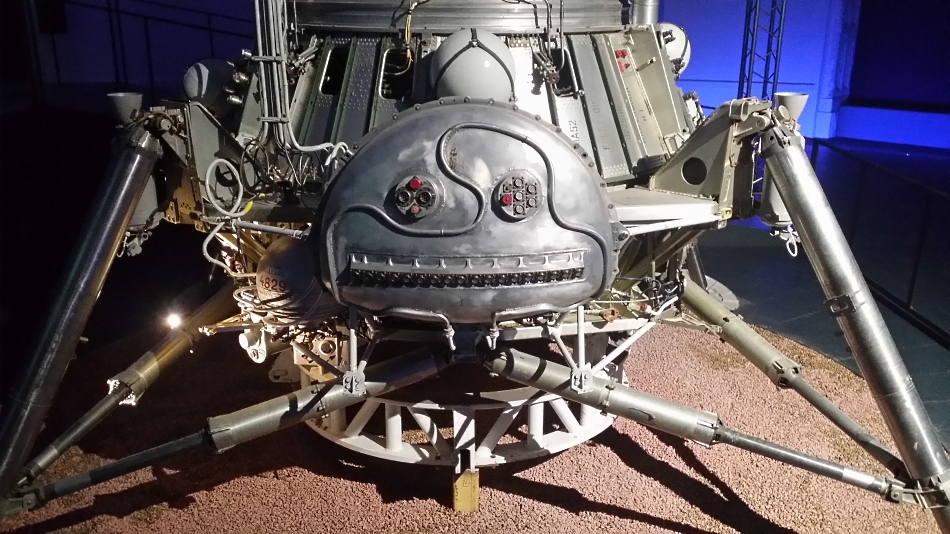
But in general, the hall is very impressive. On the walls is the film Klushantsev "Road to the Stars" , quietly playing "Listening to Bach" Artemyev - an electronic version of the prelude in B minor.
Upstairs, inside the dome, a star burns.

Photos do not convey this, but it begins to seem that the moon ship somewhere calling us. To the moon? In the cosmic future? Who knows…
First Day of the Sea of Clarity
45:51
Lecturer: Hero of the USSR, cosmonaut Alexander Laveykin.
Theme: "Is there an alternative to science?".
1:35:52
Lecturer: Andrei Lebedev, graduate student of NITU "MISiS", senior researcher of the department of development of promising photoconverters and technologies of NPP "Kvant".
Theme: "The contribution of NPP" Kvant "in the creation and development of domestic autonomous energy."
2:45:32
Lecturer: Komissarova Darya, Ph.D. in Biology, Senior Researcher, Department of Implementation Implementation and Promotion of Scientific Activities, SSC RF-IMBP RAS.
Theme: "The isolation experiments in space: why are they needed?".
3:52:38
Lecturer: Phillip lozga Terekhov, a popularization blogger.
Theme: Cosmonautics Today.
4:51:17
Lecturer: Desinov Lev Vasilievich, Head of the Earth Remote Sensing Laboratories of the Institute of Geography of the Russian Academy of Sciences.
Theme: “What is Uppsala and how does it affect your life?”.
Source: https://habr.com/ru/post/396397/
All Articles